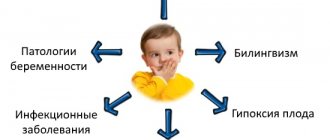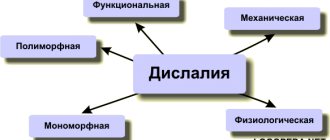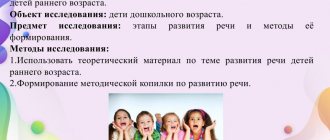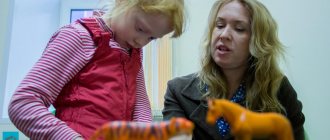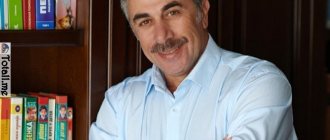Article:
Speech is divided into expressive (active) and impressive (passive).
Normally, children master two types of it; it is the understanding of oral or written speech that is the passive form and precedes the emergence of active communication. For example, with deafness it is present and is based on receiving information through the organ of vision. Blind people acquire written receptive language through tactile sensations. Impressive speech in children can be oral and written.
Speech activity consists of the perception of the sound composition of a word, its grammatical form, understanding of intonation and other means of language. It begins with the difference between someone else's and your own speech. This process occurs with the help of phonemic hearing. It is important to be able to distinguish between sounds, both hard and soft; apart from others and with continuous pronunciation. The formation of phonemic hearing ends completely at 4.5-5.5 years. Otherwise, we are talking about developmental delay.
Etiology and nature of deviation
The concepts of perception and understanding of speech are closely related. In the first case, this means how a person hears and reproduces individual sounds. However, he may not understand the meaning of what was said. For example, after reading an incomprehensible phrase, you will perceive it partially, and after clarifying the meaning of individual words, understanding will come. That is, in speech, perception through hearing or vision is primary.
Causes of impaired impressive speech:
- inversion (rearrangement of subjects and predicates in a sentence);
- inability to change the forms of words;
- failure to recognize speech sounds.
How speech understanding occurs at different periods of life can be seen from the table below.
| Skills and abilities | Child's age |
| The child is already responding to the voice of the parents | 1-1.5 months |
| Active reaction when addressed by adults (smile, waving arms, legs) | 3 months |
| Recognizes changes in intonation and responds accordingly | 4 months |
| When you contact him, there is a response hum | 5 months |
| Finds out his name | 6 months |
| Accepts requests accompanied by gestures | 7 months |
| Knows the names of the parts of the face | 7.5 months |
| Understands requests without reinforcement with gestures | 8.5 months |
| Can find already known objects in the room | 9-10 months |
| Begins to navigate using simple pictures in a book | 10-11 months |
| Knows the meaning of the word “cannot” | 11 months |
| Understands phrases like: “come”, “let’s go eat.” Can show at least two colors. | 1 year |
| Answers questions in picture books | 2 years |
| Accepts short stories and fairy tales. The baby can understand the characteristics of familiar objects, the meaning of the words hurt, loud, etc. | 2 years 5 months |
| Get to know antonyms | 3 g |
| Maintains dialogue by answering questions | 3 years 5 months |
| Perceives speech in a generally accepted form, phrases with 10 or more words | 4 years 5-6 months |
| Can answer questions: what is friendship or fear, joy | 5-6 years |
Another sign of speech perception in speech therapy is orientation in a fast paced conversation and analysis of information. Pauses help with this, but at a fast pace new words can be formed due to the merging of phonemes. In written speech, an important point is the relationship between words and the change in their forms in phrases. If the case is incorrect, it is impossible to understand the meaning of the phrase. An oral means of impressive speech is intonation. Naturally, sentences with homogeneous members and participial phrases are more difficult to perceive.
Advice to parents: while the child’s passive speech is not fully formed, use short and understandable phrases of 7-8 words for communication. Prohibitions or praise should also be concise.
Expressive and impressive speech in speech therapy
Speech activity of children is divided into 4 independent forms:
| Forms related to expressive speech | Forms related to impressive speech |
|
|
Expressive or motor speech is the process of a growing person producing specific sounds and letters using the mouth and vocal cords or writing skills. Broca's area, located in the left hemisphere in people with a dominant right hand, or in the right hemisphere in those who carry out everyday activities with the help of their left limb, is responsible for this function in the child's body.
In the presence of pathological processes or injuries to the brain center in question, children are physically unable to clearly express their thoughts, reproduce them on paper, while clearly understanding the task and information perceived aurally. The opposite of expressive speech is impressive, or sensory.
Its essence lies in the clear awareness by the brain centers of information perceived by a person through the organs of hearing or vision.
Wernicke's area is responsible for this function. If a child, as a result of an injury or due to a genetic disorder, has dysfunction in this area of the cerebral cortex (located in the left temple area), he cannot perceive words, since he does not understand their meaning and does not even identify the emotional coloring.
At the same time, his hearing organs function normally, which, when conducting a medical examination of the health status of a growing person, can provoke a misunderstanding by the pediatrician of the reasons for the significant developmental delay of a particular young patient.
In some cases, the child’s body adapts to physical “disadvantages”, compensating for them by making other senses of perception more developed.
Consequences of the disorder
Impressive speech goes through several stages in its development: from perceiving someone else’s speech to composing one’s own statements. To understand phrases, you need to know the grammatical basis of the word and its meaning.
Stages of development of receptive speech:
- I – understanding the intonation of adults;
- II – assessment of the situation in repeated conditions;
- III – the child names objects, events and actions;
- IV – final, in which the baby fulfills the requests of adults.
Receptive speech disorders cause a delay in the development of expressive speech. General underdevelopment of speech (GSD) leads to phonemic and grammatical problems and poor vocabulary. There is also a decrease in intelligence and weakness of character. Against the background of pathological processes, muscle tone weakens, static coordination and endurance deteriorate. Preschool children are characterized by clumsiness, clumsiness, lack of facial expressions, and poor coordination of movements.
The patient is unable to distinguish sounds, resulting in speech that is crumpled and inarticulate. For mild disorders, it is possible to replace sounds with similar ones, which is called literal paraphasia. They check this by quickly reading it out loud, this significantly increases the number of reservations. In the case of a severe course, a person is generally unable to understand what is being said to him.
In the course of his research, V.P. Glukhov revealed inertia, rapid depletion of combinatorial functions, and poor spatial imagination in children with ODD. When involved in the game process, their observation, motivation and self-control are reduced. Due to lack of self-confidence, they are withdrawn, aggressive, and touchy, which makes it difficult for them to adapt to society. The most difficult thing for them is to perceive information visually due to attention and memory disorders.
Conditions for organizing receptive speech:
- ability to recognize sounds;
- understanding words and meaning of phrases;
- the formation of communication skills and vocabulary through imitation and exclamation;
- teaching word semantics and grammar;
- teaching a child dialogue.
Autistic children often do not pay attention to the intonation properties of speech. So, if his parents reproach him for his misdeed, “Well, you did well!”, he will consider these words as praise and will continue to perform this action.
ABOUT THE PROBLEM OF IMPRESSIVE SPEECH IN CHILDREN
T. G. Wiesel
Institute of Defectology and Medical Psychology, Moscow.
Altai State Pedagogical University, Barnaul, Russia.
The problem of speechlessness in children, including impressive speechlessness, has been discussed in the literature for a long time. Despite this, the space of existing descriptions leaves room for the introduction of new approaches that complement theoretical concepts and specific diagnostic and didactic tasks.
The advent of modern neuroimaging technology has made it obvious that early focal brain lesions are not the cause of speech underdevelopment. Previous ideas about the analogy of the brain mechanisms of the development of aphasia turned out to be completely outdated, and the new ones that replaced them remain debatable.
In this work, we bring to your attention the neuropsychological author's concept of the patterns of development of auditory perception of speech and its types in children. It is based on our own previous research, as well as on data available in the field of modern neuroscience. According to them, the main role in the speech development of children should be played by interzonal pathways: a) association pathways, connecting individual areas of the cortex within just one hemisphere and b) commissural pathways, connecting the hemispheres. Specifically, we are talking about the timing of their myelination.
Stages of development of the impressive side of speech
At stage I of speech development, the dominant role belongs to physical hearing (PHH).
At stage II, the brain mechanisms of acquisition of non-speech hearing (NSHL) play a dominant role. This type of auditory perception is necessary for the acquisition of speech-auditory gnosis (RhSlGn-1), which is relevant at stage III, since it is from non-speech noise that useful acoustic features are extracted, which serve as the basis for mastering speech sounds.
The ability to distinguish speech sounds requires the implementation of processes of left hemisphere lateralization, and this is possible only under the condition of normative connections between the hemispheres. Failure to comply with this condition leads to the absence of onomatopoeia in expressive speech. At stage IV, the ability to discretely perceive the sound composition of a word is developed. When interzonal connections at this level are immature, the child does not understand words due to the inability to hear them. The presence of conditional speech auditory agnosia-2 (RhSlAgn-2) is recorded. If not overcome in a timely manner, such agnosia also leads to speechlessness. The final stage of auditory perception of speech (stage V) demonstrates the highest level of speech support, namely phonemic (linguistic). It develops the ability to understand meaningful words denoting objects in the surrounding world. This requires the participation of the highest in the hierarchy of the tertiary temporal cortex of the left hemisphere. The functions of the brain areas that perceive and process objects in the external world are integrated (fit into) the speech mechanism of word understanding.
As a result of interzonal interactions and integration of their functional roles, transitional areas of the brain are specialized at each stage of speech development, designed to operate speech skills that are integrative in structure and at the same time economical in the way of brain implementation. Thanks to them, fluent spoken speech (both impressive and expressive) becomes possible.
Types of impressive speechlessness Speechlessness at stage I appears as a direct consequence of deafness or severe hearing loss. At stage II, non-speech auditory agnosia (NrchSlAgn) may occur. At stage III, manifestations of speech auditory agnosia-1 (RhSlAng-1), that is, the inability to distinguish sounds, are likely. At stage IV, complications such as speech auditory agnosia-2 (RhSlAng-2), causing the inability to fully perceive the sound composition of a word by ear, are likely. At stage V, a dysfunction of the speech perception function may be detected, conventionally designated here as cacaphonemia (aFn), consisting in the inability to recode speech sounds into phonemes and, accordingly, in a lack of understanding of words. This type of impairment of auditory perception of speech is known as sensory alalia.
Correction of speechlessness The content of correctional education for speechlessness is determined by compliance with the principle formulated by L. S. Vygotsky: development proceeds from the bottom up, and decay - from the top down.
Corrective training begins from the stage at which problems are detected. Direct and bypass methods of work are used. They include a wide range of external supports, covering different modalities. The most effective is the optical-tactile method, not only for correcting sound pronunciation, but for building all the ways to bypass speechlessness based on sensory integration techniques.

